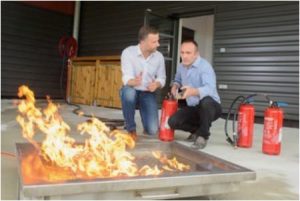 The best way to prevent workplace fires is to be aware of and lookout for potential fire hazards. All hazardous situations should be reported to your supervisor. You should know the locations of your nearest fire extinguishers, exits and other emergency equipment that is available to you.
The best way to prevent workplace fires is to be aware of and lookout for potential fire hazards. All hazardous situations should be reported to your supervisor. You should know the locations of your nearest fire extinguishers, exits and other emergency equipment that is available to you.
When we discover the presence of a fire (smoke, fumes, smoldering materials, alarms, etc.) we must react quickly but cautiously and think, “should I fight the fire or flee the scene?”. Size up the situation rapidly. Knowing when to attempt to extinguish the fire yourself and when to call for additional help is an essential decision to make.
Remember the Acronym P-A-S-S:
Be sure to remember the PASS operating technique for portable fire extinguishers. PASS stands for:
- P – Pull the pin. Pulling the pin unlocks the operating lever or button so you can discharge the extinguisher. Stand at least 6 to 8 feet from the fire.
- A – Aim low, pointing the extinguisher nozzle or hose at the base of the fire.
- S – Squeeze the lever below the handle. Squeezing the lever discharges the contents of the extinguisher. When you release the lever, the discharge stops. Some models have a button to press rather than a lever.
- S – “Sweep” by moving carefully toward the fire, keeping the extinguisher aimed at the base of the fire and sweep from side to side until the flames appear to be out.
Most extinguishers will only allow about 10 seconds of extinguishing media. Prevention is the key when it comes to firefighting. Good housekeeping, proper storage procedures, and safe work practices will go a long way toward reducing the likelihood that a fire will destroy valuable property or injure either you or a fellow employee.
LET’S AVOID HOT SITUATIONS!
Download flyer: STOTW_1049_Fire_Safety Download Spanish flyer: STOTW_1049_Fire_Safety_esp

